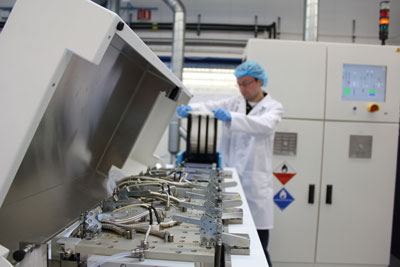New technology that allows for wireless charging of electronic devices
could make a rarity of cord jungles like the one in this image, captured
this year at a power generation station in New York City during the
blackout caused by Hurricane Sandy.
A mobile phone that charges in your pocket, a flat-screen TV that
needs no power cord, a car fueled by a cordless panel in the floor: In a
nondescript building just outside Boston, these and other applications
of wireless electricity signal a future with fewer snaking cables.
WiTricity,
a company spun off from research at the Massachusetts Institute of
Technology (MIT), aims to redefine how people use energy, making it
possible to power devices without ever plugging them into an outlet. In
WiTricity's lab, various devices run on power transmitted via electric
coils through the air.
Read more ...
WASHINGTON, July 19, 2012 /PRNewswire via COMTEX/ --
For some time, solar investors have been required to hire third party
engineers and legal counsel to perform initial project due diligence
(costing $10,000-30,000 for engineering analysis and upwards of $50,000+
for legal services) before even finalizing a term sheet. These high
transaction costs make many small commercial projects financially
unfeasible and many larger projects unattractive.
Now, investors who are considering whether to invest in a commercial or
small utility-scale project can spend just $2,000-4,000 and receive
"SolSnapshot" an initial fatal flaw analysis of risks that gives them
the confidence to push forward - or the evidence they need to put the
brakes on a project before committing significant amounts of their
firm's time and capital.
The overall aim of SolSnapshot is to reduce the costs of investing in
solar, broaden the pool of potential investments, and increase the
velocity of the solar industry.
Yuri Horwitz, CEO of Sol Systems, commented, "We see hundreds of
projects come through SolMarket, and one of the consistent barriers to
financing is an efficient way for investors to review a project's
engineering and business components. By reducing these costs through
standardization, SolSnapshot provides investors and developers with an
affordable fatal flaws analysis for a given project for a few thousand
dollars - instead of a hundred thousand, and in a few days - instead of a
few weeks."
SolSnapshot is part of Sol Systems' broader diligence services for
investors and developers and adds a layer of depth to the project
underwriting provided on SolMarket, Sol Systems' project finance arm.
It advances Sol System's larger goal of standardizing and streamlining
financing for the solar community.
Webinar: How to Diligence Your Solar Project Affordably - July 24th
Please join Sol Systems for a webinar on July 24th, 2012 at 3:30 PM EDT.
Sol Systems CEO, Yuri Horwitz, and solar industry veteran, Joe Song,
will discuss tips for investors and developers to diligence their solar
projects cost-effectively, while reducing their risks. This webinar will
be helpful for investors and developers who are involved with projects
that will soon commence a due diligence process.
About Sol Systems: Sol Systems is a solar finance firm and a leader in
financial innovation in the renewable energy industry. Since its
inception in 2008, Sol Systems has partnered with 350 installers and
developers to bring over 3,000 solar projects from conception to
completion by offering innovative financing solutions for residential,
commercial, and utility-scale projects.
SolMarket, Sol Systems' financing arm, catalyzes investments for a broad
set of solar projects by simplifying the origination, diligence, and
financing processes. Developers seeking financing for projects can
access over $2.5 billion in capital through the Sol Systems investor
network.
To participate in the webinar, please visit
www.SolMarket.com/events .
SolMarket Inquiries: Sudha Gollapudi 888-765-1115 info@solmarket.com
www.solmarket.com
Media Inquiries: Natacha Kiler 202-588-6455 pr@solsystemscompany.com
SOURCE Sol Systems, LLC
Copyright (C) 2012 PR Newswire. All rights reserved











 Comments (
Comments (
 Printable Version
Printable Version Email This
Email This Font
Font